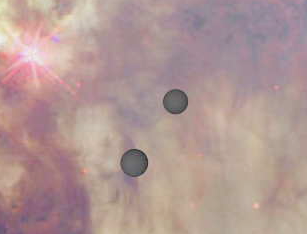We're open daily! View holiday hours
Science News
Disappearing Gravitational Waves
July 15, 2013
by Alyssa Keimach

Seashells, tornados and spiral galaxies all feature similar spiral shapes. Patterns repeat themselves in nature over and over again.
Gravity produces more abstract patterns: in much the same way that moving boats produce waves on water, moving stars can create gravitational waves in the fabric of space-time. Both types of waves lose energy as they move farther away from their source. Unfortunately, gravitational waves are very hard to measure by the time they reach Earth, and to this point, astronomers have not managed to detect gravitational waves from anywhere in the Universe.
But that doesn’t mean astronomers have given up. The quest to detect these waves has inspired scientists to figure out all kinds of ways gravitational waves might be created…
Discovered three short years ago, “monster” stars have masses between 200 and 300 times that of our sun—vastly larger than any other stars. Astronomers hoped that collisions between their supermassive remnants would produce measurable gravitational waves. At the 10th Edoardo Amaldi Conference on Gravitational Waves, Dr. Krzysztof Belczyński of the Astronomical Observatory of the Faculty of Physics at the University of Warsaw revealed his most recent findings.
Stars frequently form binary systems (two orbit around each other). Components of such systems collide once one object’s atmosphere takes over the other in a “common-envelope event.” The end result produces gamma-ray bursts accompanied by gravitational waves.
It would seem that a monster binary system would produce monster gravitational waves that even our current detectors could measure. Unfortunately, it seems that these monster stars will never get close enough to collide in the first place.
“In a supermassive binary star system, the situation is different,” says Dr. Belczyński. “We know that the components of such a system must be formed at a relatively large distance from each other. We also know that supermassive stars do not expand, so there cannot be a common envelope phase. This means that there is no physical mechanism that would effectively cause the orbit to tighten!”
“We stand practically no chance of detecting the gravitational waves from such a collision in the heavens. Unless…” Dr. Daniel Holz of the University of Chicago trails off in mid-sentence. We might detect such a collision if our current model of binary systems is wrong, which would demand a revision in our understanding of how the Universe works.
Thus the search continues for possible sources of gravitational waves—particularly of sufficient strength for us to detect. And preferably without the need to turn physics on its head.
Image: NASA